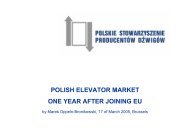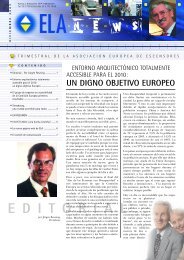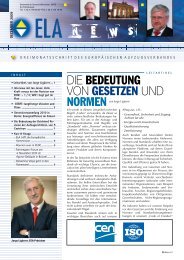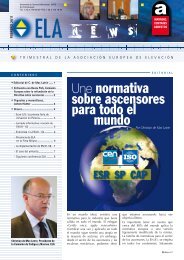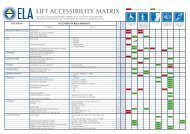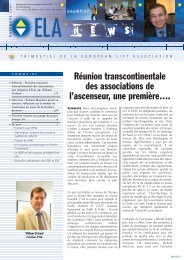WP6-Brochure-E4 brochure - ELA European Lift Association.
WP6-Brochure-E4 brochure - ELA European Lift Association.
WP6-Brochure-E4 brochure - ELA European Lift Association.
You also want an ePaper? Increase the reach of your titles
YUMPU automatically turns print PDFs into web optimized ePapers that Google loves.
• Car electronics<br />
• Light curtains / door detectors<br />
Due to the extension of the waiting times – the rebooting sequence can take up to 30 seconds<br />
– this second stand‐by mode would only be suitable for long periods of low passenger<br />
demand.<br />
Another cause for losses is that the lift shaft can facilitate thermal losses from the building.<br />
Some lift shafts are required to have vents in order to dissipate smoke in case of fire, but also,<br />
in high‐speed lifts, to reduce wind noise and transient pressure changes caused by the car<br />
movement. They also help dissipating excess heat from the lift motor. Through leaky or open<br />
basements, outside air flows into the shaft, is heated in the pit walls and rises ‐ as a result of<br />
chimney effect. This flow also draws in warm air from the heated space opposite the lift doors,<br />
which leads to comfort problems (drafts). The heated air flows outwards through the air vents<br />
at the top of the shaft.<br />
Correct insulation around the entire heated volume should be ensured to avoid such losses.<br />
The lift shaft and machine room should be well insulated and flaps in the air vents should also<br />
be airtight. Another option is to locate the lift shaft entirely on the outside of the heated<br />
volume, the lift doors leading to unheated spaces or to the outside (this solution is not always<br />
possible, for example in cold climate regions).<br />
Another cause for inefficiencies are the guide rails and shoes that ensure travel in a uniform<br />
vertical direction. Correct maintenance (e.g. alignment, lubrication) should be guaranteed to<br />
minimise the losses in these components. Furthermore, when correctly maintained, the use of<br />
roller guides is preferred to the use of sliding guides. Tests show an effective coefficient of<br />
friction for roller guides of 0,03. With sliding guides, this friction can easily be 10 times as<br />
much, especially if the lubrication is not well maintained. Sliding guides can easily cause over<br />
100 kg (1000 N) of frictional losses in the system if it is not well balanced, or if the 4 guides and<br />
rails are not perfectly co‐planar. Even with perfect balance, loads can be placed in the car off<br />
centre, causing frictional losses at the guides. In roller guides, unbalances can also cause flat<br />
spots, creating noise and reducing ride quality.<br />
45



